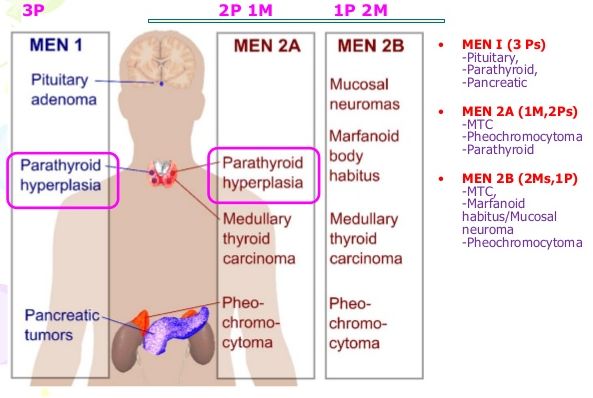MEN syndrome is an autosomal dominant (AD) predisposition to developing multiple endocrine tumors.
Mnemonic: MEN are Dominant.
Points to remember:
- Parathyroid hyperplasia is common to MEN I and MEN IIa syndrome.
- Medullary carcinoma of thyroid is common to MEN IIa and MEN IIb syndrome.
- MEN I occurs due to mutation in Menin I gene located on chromosome 11q.
- MEN II occurs due to mutation in Menin II gene located on choromsome 10q.
- MEN IV (similar to MEN I) occurs due to mutation in CDKN1B located on chromosome 12p.
MEN I or MEN 1 (Wermer’s syndrome)
Mnemonic: 3 X P’s
- Pituitary adenoma
- Parathyroid hyperplasia
- Pancreatic islet cell tumor (Zollinger-Ellison syndrome in 50% and Insulinoma in 20%)
MEN IIA or MEN 2A (Sipple’s syndrome)
Mnemonic: 3 X C’s
- Catecholamine releasing tumor: Pheochromocytoma
- Calcitonin releasing tumor: Medullary carcinoma of thyroid
- Calcium increasing: Parathyroid hyperplasia (hyperparathyroidism)
MEN IIB or 2B (MEN III)
Mnemonic: 2C 2M
- Catecholamine releasing tumor: Pheochromocytoma
- Calcitonin releasing tumor: Medullary carcinoma of thyroid
- Mucosal neuromas
- Marfanoid habitus
MEN IV or MEN 4
Men IV syndrome is clinically indistinguishable from MEN I syndrome. In addition, these may have:
- Reproductive organ tumors (e.g. testicular tumors, neuroendocrine cervical carcinoma)
- Adrenal + Renal tumors
Reference: Endocrinology: Adult and Pediatric By J. Larry Jameson, Leslie J. De Groot

